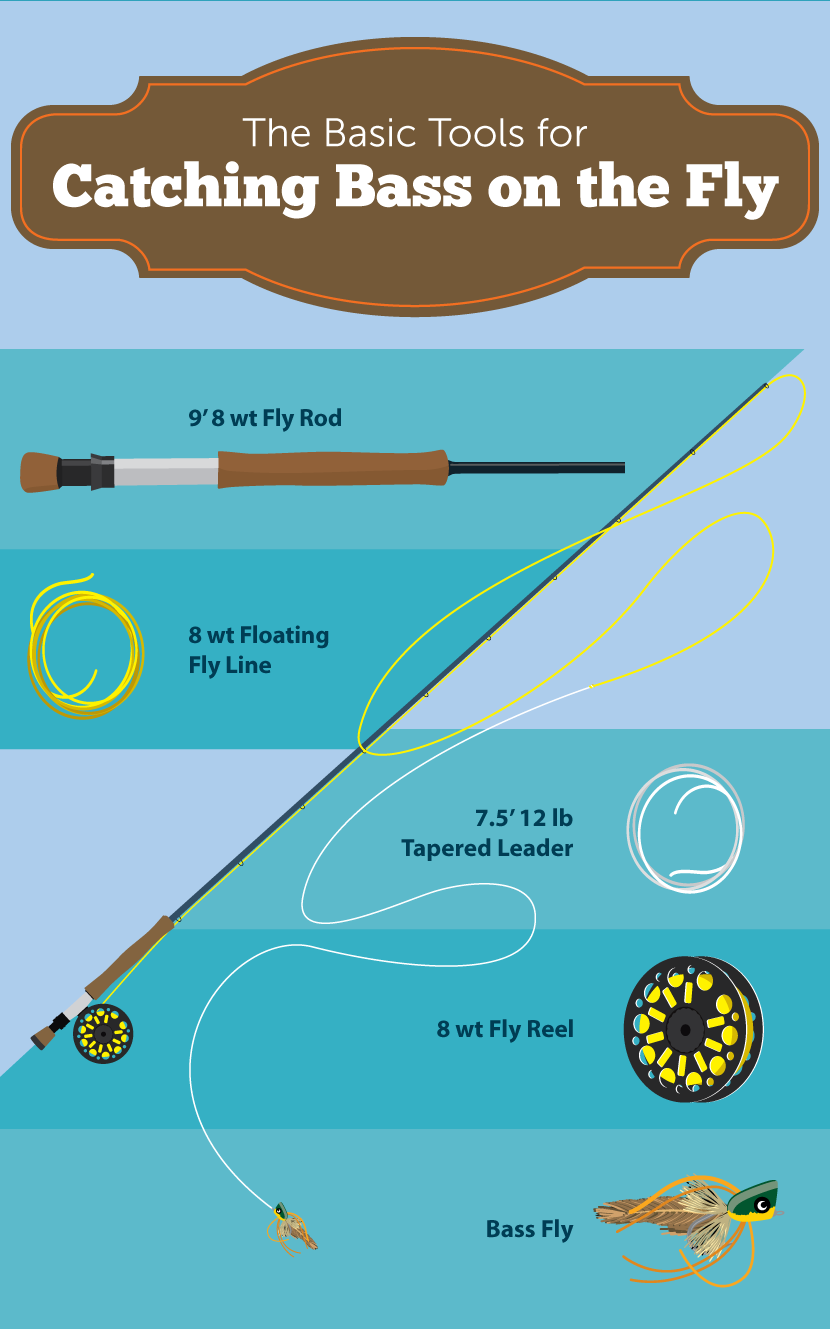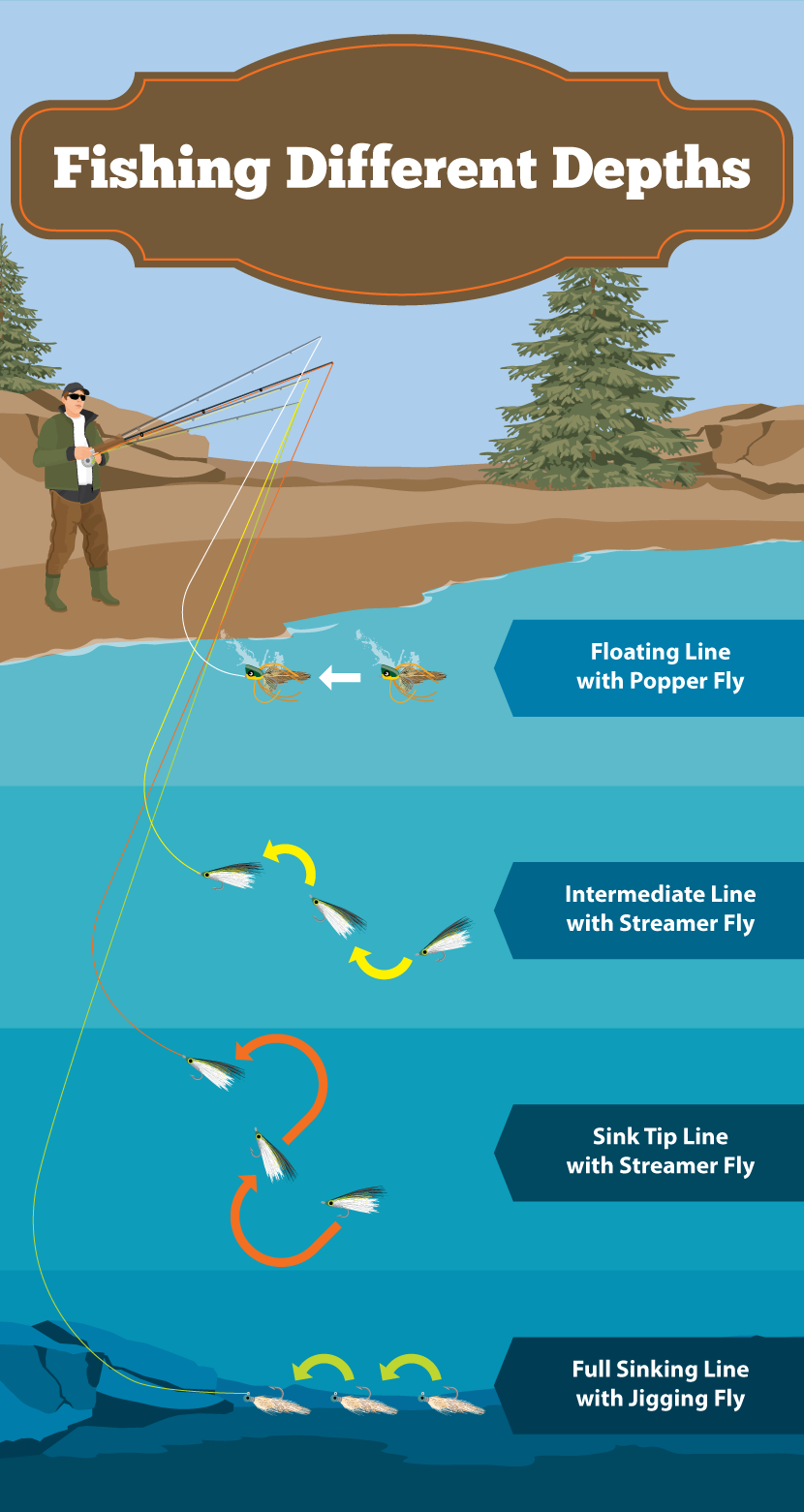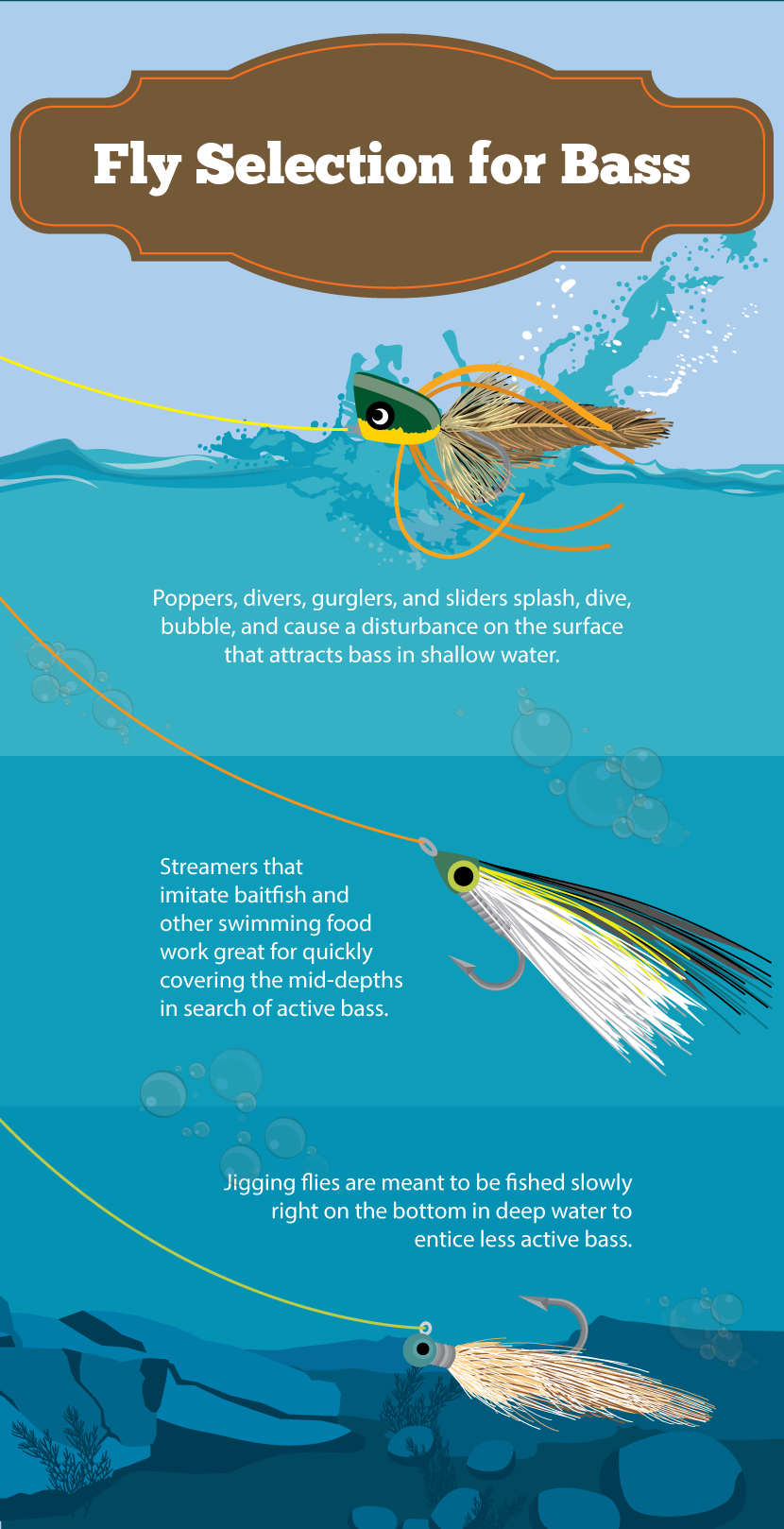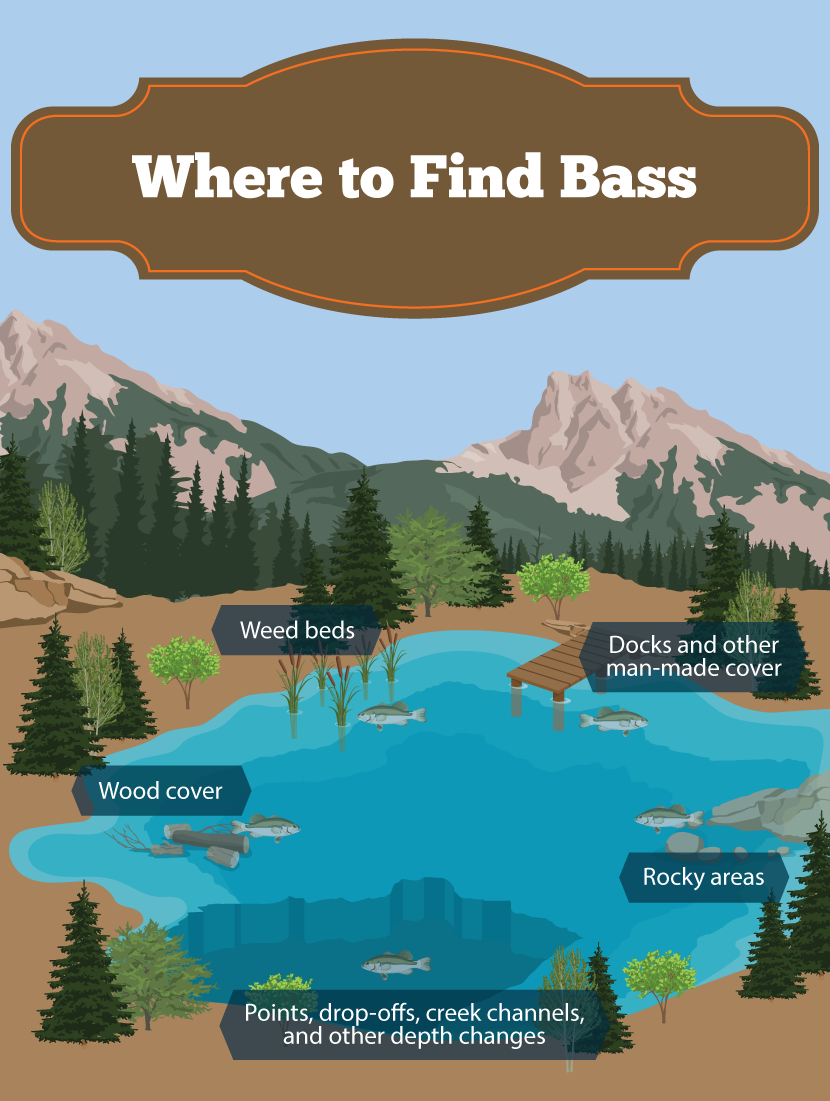How to Catch Bass on a Fly Rod
Bass are one of the most enjoyable sportfish to target with any type of tackle. For hardcore bass anglers,
fly fishing can be a fun and sporting new way to pursue their favorite species.
For fly anglers, bass are a readily available and challenging fish that are guaranteed to offer a new thrill.
Wherever you live, odds are that there is a pond, lake, or river close by that holds bass that will willingly take a fly and put up an incredible fight.
Rigging up For a Fight
Bass are well known for their awesome fighting ability on any tackle.
When targeting them, it is important to be prepared with the right equipment,
not only to haul them in, but to get the right flies into the areas where they live.
Bass are ambush predators and will often seek the heaviest cover in which to hide in wait for unwary prey to swim by.
Bass anglers are often faced with the challenge of casting their offerings directly
into snaggy or weedy areas and wrestling a hooked bass back out, so heavier than average tackle is often necessary.
For larger bass or fishing around snags and weeds, a 9-foot, 8-weight fly rod and matching reel with a strong drag is a good choice.
An 8-weight is also a good choice for casting large bass flies that would be heavy and difficult to cast on lighter rods.
For smaller bass, smaller flies, and open water, a 9-foot 6-weight rod is a good substitute.

Bass can be found lurking in any part of the water column, from just under the surface to right on the bottom.
Many anglers use only a floating line and choose to target bass when they are in shallow water,
but if you want to be prepared for any situation, having some different lines rigged up on extra reels or spare spools is a good idea.
Floating line
A weight-forward floating line with a heavy front taper is the bread and
butter of fly fishing for bass and will work well in most shallow water situations.
Bass are a shallow water predator and can often be found holding or feeding in water less than six feet deep.
Floating lines are the right choice for any surface presentation,
and work just as well when paired with a longer leader and sinking fly for getting beneath the surface.
Intermediate And Sink Tip Lines
When a sustained subsurface presentation is needed or you feel the fish are holding and feeding in water from six to 10 feet deep,
it is time to switch to a slow sinking or sink tip fly line.
Intermediate fly lines are clear colored and sink at a slow rate of one to two inches per second,
so they are perfect for pulling a fly over the top of a shallow weed bed or fishing a gradual drop off.
A sink tip fly line typically has a floating head tipped with a short section of fast sinking line at the very end.
This is good for reaching the bottom quickly and hopping the fly along drop offs, snags, and other underwater structures in shallow to medium depth water.
Fast-Sinking Fly Lines
There are times when the bass go down and the only way to catch them is to fish a fly over deep structure or crawl it right along the bottom.
A fly line with a sink rate of six to 10 inches per second is the best line for this type of presentation.
Make a long cast and count down to the proper depth before beginning the retrieve.

Leaders
Your leader choice for bass will come down to what line you are using, the size of your fly, and how much cover is present where you are fishing.
floating lines, a 7.5-foot tapered leader with a breaking strength of 12 to 15 pounds is sufficient.
For sinking and sink tip lines, a level three- to four-foot section in the same strength is fine.
For small flies or clear water with few snags, you can lighten up to six- or eight-pounds.
In the heaviest snags, or for fishing large flies, you may want to go as strong as 20 pounds.
What to Feed Bass
Bass choose from a wide menu of aquatic and terrestrial creatures to feed on, and are often more opportunistic then selective when choosing a meal.
Instead of trying to “match the hatch” in the traditional fly fishing sense,
bass anglers employ flies that dive, dart, jig, wiggle, and undulate naturally to seduce the fish into striking.
A good variety of floating bugs, unweighted streamers, and weighted “jigging” flies will allow you to fish for bass from the surface to the bottom.

Floating Bugs
Poppers, divers, gurglers, sliders, and other flies meant to create a disturbance on the surface are like candy to shallow, active bass.
Poppers are designed with a cupped face so they make a big splash or chug when given a sharp tug.
Divers float on the surface and will dive underneath with a pull on the line.
Sliders and gurglers are meant to ride near the surface while creating a bubble trail or slight disturbance,
which can be deadly for bass that might shy away from the more aggressive action of poppers and divers.
In general, big, noisy poppers and divers are best for low light or when there is some wind chop on the water,
while smaller bugs, sliders, and gurglers are great for calm water and brighter skies.
When fishing floating bugs, it is best to read the water and target cover or structure where you think the fish might be.
Cast your fly as close to the target as possible and let it settle before beginning your retrieve.
Patience is a virtue when bass fishing, and waiting for several seconds before moving the fly can pay off with an explosive strike.
If nothing takes the fly on the initial pause, begin your retrieve.
Point the rod tip directly at the fly and hold it at water level so there is no slack in the line.
Usually a slow retrieve with short twitches and jerks followed by long pauses will outfish a fast or loud, noisy retrieve.
Try to keep your fly near the “strike zone” for as long as possible.
If you can cast directly into weeds and snags and crawl the fly slowly back out without hanging up, even better.
Experiment with different retrieves and let the fish tell you what works best on any given day.
Streamers and slow sinking flies are great for fishing the middle of the water column.
They can be realistic replicas of bait fish or more generic patterns that wiggle and swim to get the attention of a bass.
Streamers work well for searching over larger areas such as submerged weeds or shallow underwater structure when you aren’t sure exactly where bass might be holding.
Fishing a streamer with slow strips and pauses works well,
but it is also effective to retrieve streamers much faster than you would fish a top water fly to cover the water and search out active fish.
Make sure the rod tip is pointed right at the fly so you can feel the take.
Strikes can range from a subtle bump or pressure on the line to a full throttled rod bending slam, so be ready for anything!
Weighted “jigging” style flies are one of the most effective, yet least employed fly styles for catching bass.
A heavy head and upturned hook help keep the fly snag free when it is crawled or hopped right along the bottom.
Jig style flies work best when there is a specific location such as a drop off, sunken log, or rock pile on the bottom that you suspect holds fish.
The snagless design and weighted fly allow you to reach the targeted zone quickly and dance the fly right in front of the fish throughout the retrieve.
Cast the fly out past the area you are trying to fish and wait for it to sink down near the bottom before retrieving it.
Just as with topwater fishing, it is worthwhile to let the fly settle before bringing it in.
Many strikes occur while the fly is just resting, right after the initial cast.
When you are ready to begin the retrieve, bring the fly in with a series of short strips, hops, and varying length pauses, allowing the fly to rise and then settle back to the bottom.
Strikes can be tough to discern when fishing deep, so pay close attention to the line,
and if you feel the fly contact anything or you see the fly line move unnaturally, set the hook.
Where to Find Bass
Finding bass in any body of water is a matter of learning to recognize the different types of cover and structure where they like to rest and feed.
Underwater or above water cover such as weeds, woody debris, docks, and even shade can all attract bass.
Structure such as rock piles, points, drop offs, and channels are also important to bass,
especially if any of the previously mentioned types of cover are present as well.
Learning to locate and fish these different types of cover and structure effectively
takes time and experience, but it will pay off with big bass on the end of your line.
Weeds
Weeds can come in many different forms, but one thing remains the same: find weeds and you will find bass.
Look for edges where the weeds drop off into deeper water or meet the shoreline and fish top water lures and streamers parallel to the weed line.
Cast a floating bug into pockets, holes, and irregularities in a weed bed and twitch it around the openings.
If the weeds form a mat on the surface, try crawling a fly with a good weed guard right over the top. On hot summer days,
bass will hold in the shade beneath matted weeds and explode straight through the canopy to attack your fly.
Wood
Woody cover such as fallen logs, submerged trees, old stumps, and sunken bushes are all magnets for bass.
They attract the baitfish that bass feed on and give the bass a secure place to hide and ambush their prey.
In shallow water, you can often see these objects extending from the bank or sticking out of the water.
It is a good idea to work any piece of wood cover with many presentations from different angles, starting at the outside edge and working slowly toward the deepest part of the snag.
Don’t be afraid to cast your fly right into the middle of it.
You might snag up, but that is the price of admission for hooking big bass that are hiding in heavy cover.
All different types of flies can be used to pick apart wood cover; just make sure they have good weed guards.
Floating flies are great in shallow water because you can cast them right up against the branches and twitch them enticingly without moving the fly away from the strike zone.
The longer you leave the fly there, the bigger the bass you can expect to catch!
When fishing sunken brush piles and other wood cover on the bottom,
a heavier jig style fly on a long leader or a sinking line will help you maintain contact and “feel” the fly through the snag.
Hop the fly and pause it, allowing it to free fall through the branches.
If the fish are fairly active and holding closer to the outer branches,
an un-weighted streamer fished quickly over or alongside the outer edges of logs and stickups can elicit strikes.

Manmade Cover
Docks, boat slips, old fence rows, bridges, and other manmade objects can hold bass in the right conditions.
The best cover will have access to deep water while providing plenty of shade and overhead protection.
Casting a fly to the outer edges, any adjoining corners, and directly underneath these objects can produce a big bass.
Rocks
Rocks are great places to look for bass, especially if they are combined with other forms of cover or structure.
Rocks create natural hiding places for bass and the creatures they like to eat, such as crayfish, minnows,
and other small fish. In general, areas with rocks of various sizes, large and small,
will hold more fish than uniform cobble or gravel bottoms. The bigger boulders give bass a good hiding spot where they can sit and wait for their next meal.
Jigging style flies shine in rocky areas because you can hop and bounce
them over and through the crevices without snagging up, and they do a good job of imitating crayfish.
Drop Offs
Anywhere shallow water drops into deeper water is a good area to look for bass.
This includes points jutting into a body of water, as well as channels formed by an old creek bed. Drop offs give bass a transition
area where they can hold and rest in deeper water while making forays into the shallows to look for food.
It doesn’t take much of a depth change to hold bass, but it helps if the drop off is accompanied by a form of cover such as weeds,
wood, or rocks, which attract food and give bass multiple ambush points from which to attack their prey.
How you fish a drop off will depend mostly on its contour.
A steep, vertical drop that quickly changes depth is best fished with a sinking line and a jigging fly hopped from shallow to deep or vice versa.
A gradual drop-off can be fished with a searching presentation such as a fast-moving streamer on an intermediate line.
If there are other forms of cover on the drop off, target them with slow moving presentations such as jigging flies or top water, if it is not too deep.
How to Fight Bass
Bass are an aggressive fighter and must be approached differently than a trout when using fly tackle.
Anglers not used to bass, or not used to fly fishing, may have a hard time hooking and landing them, especially when fishing around the heavy cover where they live.
This section will discuss the fighting methods that help fly anglers hook the fish, keep them on the line, and bring more of them to hand.
Developing a good hook set is paramount if you want to catch bass on a fly rod. Bass have big mouths and hard,
bony jaws that make them tough to hook with long, limber fly rods.
Instead of lifting the rod to set the hook, as is common with conventional bass fishing,
fly fishers use a technique called the strip set to achieve the power needed to penetrate the bass’ bony jaw.
When you feel or see a strike, give a hard, long pull on the fly line with the rod tip pointed right at the fish.
The direct connection will give you the most possible power on your hook set and will work much better than using the soft spongy tip of the fly rod.
It may be necessary to follow up with one or two more pulls to make sure the hook is firmly seated.
The Fight
When the fish is hooked and the fight begins, keep the rod bent at a 45-degree angle to maintain pressure on the fish.
Battles with bass are usually intense but short, so the most important thing is to keep the line tight and steer the fish away from any snags or obstacles it may try and swim into.
Most lost fish are a result of slack developing in the line, allowing the fish to throw the hook.
If you are using the proper strength leader you shouldn’t need worry too much about breaking off.
With a heavy tippet, even large bass can be stripped in by hand and do not need to be fought using the reel.
Fight them hard and bring them in quickly. You will land a higher percentage of bass and release them healthy to fight another day.
Embed the article on your site

